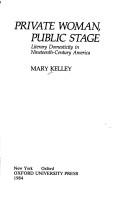| Listing 1 - 3 of 3 |
Sort by
|

ISBN: 0674250354 9780674250352 Year: 1987 Publisher: Cambridge, Massachusetts Harvard University Press
Abstract | Keywords | Export | Availability | Bookmark
 Loading...
Loading...Choose an application
- Reference Manager
- EndNote
- RefWorks (Direct export to RefWorks)
Traces the roots of Dickinson's unusual, compressed, ungrammatical, and richly ambiguous style of poetry.
Women --- Language and languages --- Language --- Sex differences --- Dickinson, Emily, --- Dickinson, Emilia, --- Dickinson, Emily Elizabeth, --- Dickinson, Emily --- Dikinson, Ėmili, --- D̲ikinson, Emily, --- Ti-chin-sen, Ai-mi-li, --- דיקינסון, אמילי, --- Dykinsan, Ėmili, --- Language.

ISBN: 0195033515 9780195033519 Year: 1984 Publisher: New York Oxford University Press
Abstract | Keywords | Export | Availability | Bookmark
 Loading...
Loading...Choose an application
- Reference Manager
- EndNote
- RefWorks (Direct export to RefWorks)
"In the decades spanning the nineteenth century, thousands of women entered the literary marketplace. Twelve of the century's most successful women writers provide the focus for Mary Kelley's landmark study: Maria Cummins, Caroline Howard Gilman, Caroline Lee Hentz, Mary Jane Holmes, Maria McIntosh, Sara Parton, Catharine Maria Sedgwick, E.D.E.N. Southworth, Harriet Beecher Stowe, Mary Virginia Terhune, Susan Warner, and Augusta Evans Wilson. These women shared more than commercial success. Collectively they created fictions that Kelley terms "literary domesticity," books that both embraced and called into question the complicated expectations shaping the lives of so many nineteenth-century women. Matured in a culture of domesticity and dismissed by a male writing establishment, they struggled to reconcile public recognition with the traditional roles of wife and mother. Drawing on the 200 volumes of published prose and on the letters, diaries, and journals of these writers, Kelley explores the tensions that accompanied their unprecedented literary success."--Google Books (re: new edition).
American fiction --- Women and literature --- American fiction --- Authorship --- Domestic fiction, American --- Women --- Authors, American --- Women --- Women --- Women authors, American --- Public opinion in literature --- Sex role in literature --- Privacy in literature --- Women in literature --- American fiction --- Women authors --- History and criticism --- History --- History and criticism --- Sex differences --- History --- History and criticism --- History --- Books and reading --- Intellectual life --- History and criticism
Book
ISBN: 9780062748201 0062748203 9780062864369 006286436X Year: 2018 Publisher: New York, NY Amistad, an imprint of HarperCollins Publishers
Abstract | Keywords | Export | Availability | Bookmark
 Loading...
Loading...Choose an application
- Reference Manager
- EndNote
- RefWorks (Direct export to RefWorks)
"In 1927, Zora Neale Hurston went to Plateau, Alabama, just outside Mobile, to interview eighty-six-year-old Cudjo Lewis. Of the millions of men, women, and children transported from Africa to America as slaves, Cudjo was then the only person alive to tell the story of this integral part of the nation's history. Hurston was there to record Cudjo's firsthand account of the raid that led to his capture and bondage fifty years after the Atlantic slave trade was outlawed in the United States. In 1931, Hurston returned to Plateau, the African-centric community three miles from Mobile founded by Cudjo and other former slaves from his ship. Spending more than three months there, she talked in depth with Cudjo about the details of his life. During those weeks, the young writer and the elderly formerly enslaved man ate peaches and watermelon that grew in the backyard and talked about Cudjo's past--memories from his childhood in Africa, the horrors of being captured and held in a barracoon for selection by American slavers, the harrowing experience of the Middle Passage packed with more than 100 other souls aboard the Clotilda, and the years he spent in slavery until the end of the Civil War. Based on those interviews, featuring Cudjo's unique vernacular, and written from Hurston's perspective with the compassion and singular style that have made her one of the preeminent American authors of the twentieth-century, Barracoon masterfully illustrates the tragedy of slavery and of one life forever defined by it. Offering insight into the pernicious legacy that continues to haunt us all, black and white, this poignant and powerful work is an invaluable contribution to our shared history and culture."--Publisher's website.
Enslaved persons --- West Africans --- Slave trade --- Slavery --- Slave ships --- History --- Lewis, Cudjo --- Clotilda (Ship) --- Mobile (Ala.)
| Listing 1 - 3 of 3 |
Sort by
|

 Search
Search Feedback
Feedback About UniCat
About UniCat  Help
Help News
News